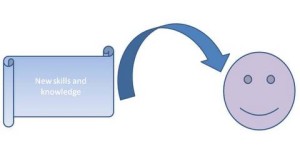Perhaps you are the person in your organization responsible for making sure everyone learns a critical new procedure. Everyone attends a full-day training. The training event gets great reviews in the follow-up surveys, and the participants earn high scores on tests given at the end of the session. But when the participants get back on the job, they have trouble applying what they learned and don’t follow the new procedure. What happened? Or rather, didn’t happen? Learning transfer. And when learning transfer doesn’t happen, it’s costly. Not only because the new procedure isn’t used properly (or at all), but also because of all the costs that go into training, and potentially re-training members of the organization.
What is learning transfer? It’s the ability of learners to apply what they learned in the “classroom” to their real-world environment. If you are familiar with the Kirkpatrick Model of training evaluation, you might think of this as Level 3, measuring how well learners apply what they’ve learned. The good news is that it’s possible to design instruction in a way that promotes learning transfer. Recent research about how our brains learn has found remarkable things with direct application to the learning environment. Instruction designed with a focus on these concepts is far more likely to result in learning transfer.
Here’s an example. Research shows that our brains are constantly seeking new and interesting stimuli and there are limits to the amount of time we can successfully stay focused on one particular task (Sousa, 2011). This means that in a learning setting, our minds will begin to wander, looking for novelty if the instruction does not provide it. So when an instructor stands in front of a group lecturing for an hour, what do you think happens? Most listeners probably check out after the first 10-15 minutes, thinking about all kinds of things that are most likely not related to the instruction. John Medina (2008) refers to this as the 10-minute rule and designs his lectures around this concept, introducing something to refocus interest right before each 10-minute mark.
How do we ensure that training-time is time well-spent? That participants come away from training able to apply what they’ve learned? That the same training doesn’t have to be re-administered a few months down the road because it hasn’t been applied?
The key is to consider learning transfer when designing every aspect of instruction: the learning environment, the format. the content, and everything else. In this way, the resources spent on developing, implementing, and participating in training result in the maximum benefit to the organization and its people.
References:
McGinty, J., Radin, J., & Kaminski, K. (2013). Brain-friendly teaching supports learning transfer. In L. M. Kaiser, K. Kaminski, & J. M. Foley (Eds.), New directions for adult and continuing education: Learning transfer in adult education, pp. 49-59). Hoboken, NJ: Wiley Periodicals, Inc.
Medina, J. J. (2008). Brain rules: 12 principles for surviving and thriving at work, home, and school. [Kindle]. Retrieved from eISBN: 978-0-979=77778-3
Sousa, D. A. (2011). How the brain learns (4th ed.). Thousand Oaks, CA: SAGE.

